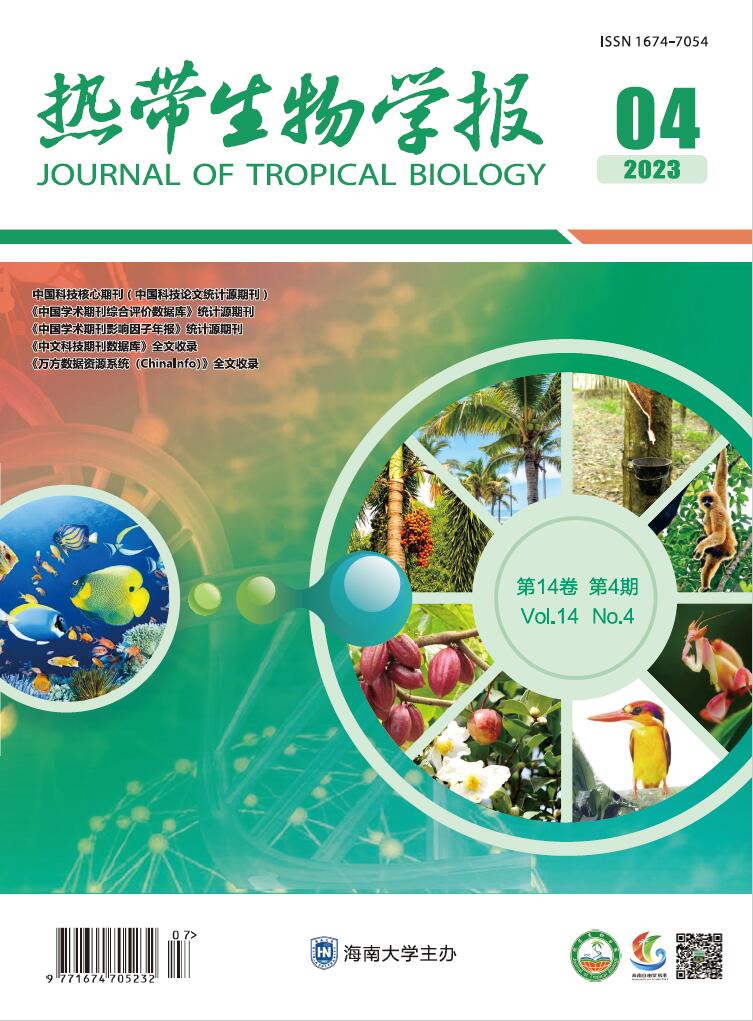-
紫薇(Lagerstroemia indica)别名痒痒树、百日红、无皮树,是千屈菜科紫薇属落叶灌木或小乔木,产于我国中部及南方各省。紫薇树姿优美、树干光滑、花色艳丽、花期长,是重要的夏季观花冬季观干的景观植物,也是优良的园林观赏树种。我国紫薇属植物的育种起步较晚,目前的研究主要集中在种质资源收集[1-3]、杂交育种[4-5]、倍性育种[6-8]和栽培繁殖[9-11]等方面。辐射诱变是植物育种的重要方法,诱变育种可诱发较高的突变率,获得全新的变异类型,是观赏植物育种中一种有效的方法。60Co-γ 射线是观赏植物育种中最常用的辐射诱变源,具有成本低、突变率高,穿透力强等优点[12-15]。电子束辐射具有电子流聚束效果好、能量利用率高、操作简单等优点[16],目前在作物和观赏植物中的应用较少[17-22],也尚未见到紫薇属植物电子束诱变育种方面的报道。由于不同植物对辐照的敏感度不同,选择适宜的辐照剂量可提高突变频率和育种效率,笔者利用不同剂量的60Co-γ和电子束辐射对紫薇种子进行处理,研究不同剂量的辐射对紫薇种子萌发和幼苗生长的影响,确定紫薇合适的辐照剂量,旨在获得有价值的突变体,为紫薇优良品种的选育提供新型的育种材料。
HTML
-
植物材料为紫薇(Lagerstroemia indica)种内自然杂交的当年成熟干种子。60Co-γ照射处理采用上海市农业科学院作物栽培研究所辐照中心钴源,照射剂量率100 Gy·h−1,照射剂量为50~250 Gy。电子束照射采用上海农业科学院的直线电子加速器产生的能量为10MeV的电子束,辐照剂量范围为200~500 Gy。
-
每个辐照剂量处理500粒种子,5次重复,并设置相应的空白对照。60Co-γ辐照共设置了5组不同辐照量的处理和1组对照,每组处理2 500颗种子;电子束辐照共设置了7组不同剂量的处理组和1组对照组,每组处理2 500颗种子。草炭和珍珠岩(1∶1)作为基质混匀后充分浇水,4月份将处理后的种子播种在育苗穴盘中,随后放置在塑料大棚中,定期调查种子发芽量和幼苗生长情况。播种后每天观察萌发情况,记录发芽日期和数量,计算发芽率。发芽完成后,观察幼苗叶片生长情况,幼苗生长稳定后统计每个处理的成苗数量,计算成苗率。当年11~12月份测量幼苗生长指标。株高为植物自地上基部到顶端生长点的高度,用卷尺测量;地径为离开地面1 cm处的茎干直径,用游标卡尺测量;分枝长用直尺测量,为主干分枝处至枝条顶端生长点的长度。
发芽率/%=(种子发芽量/供试种子量)×100%;
成苗率/%=(成苗数量/供试种子量)×100%。
-
半致死剂量(LD50)指以成苗率为指标,找出成苗率为对照一半的剂量,此时的诱变效果为理论上最佳[23]。以辐射量x为自变量,不同剂量下的成苗率为因变量y,利用Excel得出直线回归方程y=a+bx,计算半致死剂量[24]。
-
采用SPSS19.0和Excel对数据统计分析。
1.1. 试验材料
1.2. 试验设计
1.3. 辐照半致死率的确定
1.4. 数据分析
-
紫薇种子受60Co-γ辐照后发芽率均有影响,除100 Gy辐照组发芽率比对照组高2.15%,其余4组辐射组发芽率均低于对照组(表1)。始发芽天数影响较小,除50,250 Gy 2组辐照组比对照组始发芽天数均多1 d,其余3组辐照组与对照组无差异。发芽完成天数影响较大,5组辐射组比对照组发芽完成天数均有明显延迟,100,200 Gy 2组延迟天数最多,比对照组均延迟5 d。150,250 Gy辐照组也比对照组延迟4 d。5组辐射组的成苗率比对照组均有明显下降,其中250 Gy的成苗率最低,比对照组低58.9%。
项目 Item 辐照剂量 Irradiation dose/Gy CK 50 100 150 200 250 发芽率/% Germination rate 54.6 66.4 59.2 63.6 58.2 65 始发芽天数/d Days for initial germination 12 11 11 11 12 11 发芽完成天数/d Days for germination of all seeds 22 25 24 25 24 20 成苗率/% Seedling survival rate 34.4 36.6 35 28.8 23.2 56.4 Table 1. The effects of 60Co-γ on seed germination and seedling survival rate of Lagerstroemia indica
-
电子束辐照对紫薇种子的发芽率有较明显的影响,200~500 Gy范围内发芽率低于对照组,其中250 Gy组发芽率最高(表2)。7组处理组始发芽天数均有延迟,400,500 Gy比对照组延迟3 d,其余5组均延迟2 d。发芽完成天数也有较明显的影响,350,450 Gy 2组处理比对照组延迟4 d,其余5组均有3 d的延迟。电子束辐照对成苗率有明显影响,7组处理的成苗率均有较大幅度的下降,低于对照组30.5%~76.95%,其中500 Gy组最低,比对照组低76.95%。
项目 Item 辐照剂量 Irradiation dose/Gy CK 200 250 300 350 400 450 500 发芽率/% Germination rate 46.8 57.4 50.2 46.4 56.6 48.4 41.6 65 始发芽天数/d Days for initial germination 13 13 13 13 14 13 14 11 发芽完成天数/d Days for germination of all seeds 23 23 23 24 23 24 23 20 成苗率/% Seedling survival rate 39.2 33.6 30 21 18.8 16.2 13 56.4 Table 2. The effects of electron beam irradiation on seed germination and seedling survival rate of Lagerstroemia indica
-
对实验数据进行线性拟合,得到2种辐照不同剂量处理下紫薇种子的出苗率剂量效应曲线和不同致死率估计量,如图1和表3所示。

Figure 1. Regression curves for correlation of 2 types of irradiation with the seedling rate of Lagerstroemia indica
辐照类别
Irradiation回归模型
Regression equation复相关系数
Multiple correlation coefficient不同致死率估计剂量/Gy
Estimated dose of different mortality rates/Gy40% 50% 60% 60Co-γ y=72.12−0.107 2x 0.741 5 299.63 206.34 113.06 离子束 EB y=98.74−0.157 8x 0.964 2 372.24 308.87 245.5 注:x为辐照量(Gy),y为成苗率。
Note: x is irradiation dosage; y is seedling survival rate; EB means electron beam.Table 3. Regression equations and different mortality rates of Lagerstroemia indica
-
根据生长指标统计,不同剂量60Co-γ辐照显著影响了紫薇幼苗的生长(表4)。幼苗株高在100 Gy辐照组显著低于对照组,比对照组低14.3%,而200,250 Gy高辐照组与对照组却无显著差异。5组辐照组的幼苗分枝长都显著短于对照组,其中100 Gy组分枝长最短,比对照组短34.8%。幼苗分枝数5组辐照组均显著少于对照组,其中在100~250 Gy的辐照区间内,随着辐照剂量的增大,分枝数有逐渐增多的趋势,50 Gy组的分枝数略高于100 Gy组,但无显著性差异。50,150,250 Gy 3组辐照组的幼苗地径显著低于对照组,而100,200 Gy组的幼苗地径和对照组无显著性差异。
指标 Index 辐照剂量 Irradiation dose/Gy CK 50 100 150 200 250 株高/cm Height 26.22±4.84ab 24.33±5.93b 26.95±8.28ab 27.65±7.02a 28.10±6.21a 28.39±3.50a 分枝长/cm Branch length 37.83±9.02bc 34.08±11.31c 41.06±15.92bc 41.77±17.45b 41.65±15.19b 52.27±13.62a 分枝数/个 Branches 2.50±1.07b 2.27±1.26b 2.57±1.43b 2.73±1.91b 2.87±1.74b 3.70±1.42a 地径/mm Ground diameter 4.12±0.73b 4.41±0.62ab 4.37±0.70b 4.48±0.91ab 4.24±0.77b 4.76±0.66a 注:同一行数字后标注不同小写字母代表不同处理间差异显著(P<0.05),以下同。
Note: Different lowercase letters in a row indicate significant differences at 0. 05 level under different irradiation dosages.Table 4. The effects of 60Co-γ on the seedling growth indexes of Lagerstroemia indica
-
根据生长指标统计,不同剂量电子束辐照影响了紫薇幼苗的生长情况(见表5)。200,300,450 Gy 3组辐照组的株高显著低于对照组,其中450 Gy组比对照组低16.87%。幼苗分枝长在电子束辐照处理下有明显影响,除250 Gy组,其余6组均显著短于对照组,300 Gy组的幼苗分枝长最短,比对照组短45.19%。电子束辐照处理对幼苗分枝个数有较明显影响,300,450,500 Gy 3组处理的分枝数显著少于对照组,且450,500 Gy 2组高辐照组分枝数显著减少,450 Gy处理下幼苗分枝个数最少,比对照少43.24%。电子束辐照对幼苗地径的影响较小,仅450 Gy辐照组显著低于对照组,比对照组低15.34%,其余辐照组未有显著差异。
指标 Index 辐照剂量 Irradiation dose/Gy CK 200 250 300 350 400 450 500 株高/cm Height 24.71±4.92cd 28.42±5.19a 25.49±5.06bcd 26.89±6.56abc 27.80±5.68ab 23.60±5.45d 26.51±7.35abc 28.39±3.50a 分枝长/cm
Branch length44.50±14.37b 57.07±7.70a 28.65±5.45c 30.22±6.58c 29.90±5.81c 32.31±14.63c 39.13±17.96b 52.27±13.62a 分枝数/个
Branches3.20±1.75abc 2.97±1.81abc 2.73±1.87bcd 3.17±1.74abc 3.33±1.35ab 2.1±1.56d 2.37±1.59cd 3.70±1.42a 地径/mm
Ground
diameter4.68±0.88ab 5.00±0.93a 4.91±0.81ab 4.63±0.86ab 4.52±0.71b 4.03±0.87c 4.84±0.73ab 4.76±0.66ab Table 5. The effects of electron beam irradiation on seedling growth indexes of Lagerstroemia indica
-
不同剂量的2种辐照对紫薇株高、分枝长、分枝数和地径的生物统计分析结果(表6)表明,幼苗的株高和分枝数,2种辐照的不同辐照组之间并未有明显差异。60Co-γ的100 Gy辐照组和电子束300,350,400,450 Gy这5组辐照组的分枝长均显著短于对照组,其中电子束300 Gy辐照组最短。电子束250 Gy辐照组地径显著高于60Co-γ 5组辐照组,与对照相比,电子束450 Gy辐照组地径最短,电子束250 Gy辐照组地径最高。
处理
Treatment株高
Plant height/cm分枝长
Branching length/cm分枝数
Number of branches/个地径
Ground diameter /cm60Co-γ(50 Gy) 26.22±4.84a 37.83 ±9.02bc 2.50±1.07a 4.12±0.73cd 60Co-γ(100 Gy) 24.33±5.93a 34.08±11.31c 2.27±1.26a 4.41±0.62 abcd 60Co-γ(150 Gy) 26.95±8.28a 41.06±15.92bc 2.57±1.43a 4.37±0.70abcd 60Co-γ(200 Gy) 27.65±7.02a 41.77±17.45bc 2.73±1.91a 4.48±0.91 abcd 60Co-γ(250 Gy) 28.10±6.21a 41.65±15.19bc 2.87±1.74a 4.24±0.77bcd 电子束(200 Gy)EB 24.71±4.92a 44.50±14.37abc 3.20±1.75a 4.68±0.88abcd 电子束(250 Gy)EB 28.42±5.19a 57.07±7.70a 2.97±1.81a 5.00±0.93a 电子束(300 Gy)EB 25.49±5.06a 28.65±5.45c 2.73±1.87a 4.91±0.81ab 电子束(350 Gy)EB 26.89±6.56a 30.22±6.58c 3.17±1.74a 4.63±0.86abcd 电子束(400 Gy)EB 27.80±5.68a 29.90±5.81c 3.33±1.35a 4.52±0.71abcd 电子束(450 Gy)EB 23.60±5.45a 32.31±14.63c 2.10±1.56a 4.03±0.87d 电子束(500 Gy)EB 26.51±7.35a 39.13±17.96bc 2.37±1.59a 4.84±0.73abc CK 28.39±3.50a 52.27±13.62ab 3.70±1.42a 4.76±0.66abcd Table 6. The effects of two types of irradiation on seedling growth indexes of Lagerstroemia indica
2.1. 辐照对种子发芽和成苗率的影响
2.1.1. 60Co-γ辐照对紫薇种子发芽和成苗率的影响
2.1.2. 电子束辐照对紫薇种子发芽和成苗率的影响
2.1.3. 两种辐照不同致死率估计剂量的确定
2.2. 辐照对幼苗生长指标的影响
2.2.1. 60Co-γ辐照对紫薇幼苗生长的影响
2.2.2. 电子束辐照对紫薇幼苗生长的影响
2.2.3. 2种辐照对紫薇幼苗生长的综合影响
-
60Co-γ射线和电子束的产生原理和作用机制不尽相同,其对紫薇辐照效果的差异研究尚鲜见报道。种子的发芽率和成苗率是育种成功的基础,本试验显示60Co-γ和电子束均会对紫薇种子的发芽率产生影响,其中60Co-γ辐照对紫薇种子的发芽率影响较小。相比发芽率,2种辐照处理下紫薇的成苗率和发芽天数均有较明显的影响,但紫薇幼苗生长的株高和分枝数未有明显差异。试验结果表明,在相同剂量条件下(250 Gy),电子束辐照处理下的紫薇幼苗分枝长更长,地径更大,电子束辐照对紫薇幼苗分枝长和地径表观性状发生的变异更大。近年来有研究人员认为通过成苗率计算半致死剂量,且在20%上下选择2个剂量可以产生更多的突变率[25]。笔者通过试验,计算出紫薇干种子在60Co-γ辐照的范围为113.06~299.63 Gy,在电子束辐照的范围为245.5~372.24 Gy。这些结果可以为紫薇的诱变育种提供数据基础,也可以为其他花卉植物的辐射诱变提供参考。
-
2种辐照显示随着辐照剂量的增加,发芽率均先升高后降低,推测可能是低剂量处理破坏了种皮的结构从而促进种子萌发,但有文献推测其原因是低剂量的辐照会打破种子休眠,在种子萌发的早期活化相关蛋白和RNA,从而提高种子萌发率[26];而高剂量辐照会破坏部分种胚导致种子活力降低。2种辐照处理下紫薇的成苗率均显著降低,这可能是由于辐照导致植物细胞分裂受抑制,这种抑制随芽苗生长不断显现,最终导致幼苗生长困难甚至不能成苗[27],这与鸢尾、万寿菊和高羊茅中的研究结果一致[28-30]。辐照可以导致细胞多水平的变化,从而引起植物形态的变化,幼苗的生长状况是衡量辐照生物学效应的重要指标。本试验结果表明60Co-γ 3组高剂量组分枝长和分枝数逐渐增加,推测可能是高剂量辐照处理抑制了植株的顶端优势,从而在一定范围内促进了侧芽的发育。电子束辐照低剂量处理组分枝长比对照显著增长,推测可能是低辐照处理所致损伤程度较低,刺激植物激素的合成,引起一系列修复反应,从而减轻辐照的损伤以更好抵御外界的干扰,而高剂量辐照表现出对幼苗生长的抑制作用,可能与细胞分裂G2/M期受阻有关。
辐射育种可以打破基因连锁,提高重组率,改变品种单一性状和缩短育种周期,因此被广泛应用于观赏植物和农作物中。亲本的选择是辐射育种成功的基础,要尽可能选择易发生突变的基因型和杂合材料,杂合材料经辐射处理后发生隐性突变的性状比纯合体易于显现,有利于提高后代的突变频率和选择几率。在育种操作中,辐照技术可以和组织培养、现代分子生物学技术相结合,提高突变体的选择效率和增殖速度,加快观赏植物新品种选育的进程。







 DownLoad:
DownLoad: